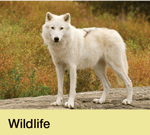Transporting Wildlife Species or Their Hybrids
 When considering interstate or international travel for captive wildlife species or hybrids of such, plan ahead because some preparations may need to start months in advance.
When considering interstate or international travel for captive wildlife species or hybrids of such, plan ahead because some preparations may need to start months in advance.
The information contained in this section is supplemental to Transporting Animals - Basic Requirements and Considerations and Basic Timeline for Interstate and International Travel with Animals, which apply to all animal species. In addition, please review the following AVMA resources, which were designed for animal owners needing to move animals from one place to another.
- Traveling With Your Pet (video)
- Travel certificates for pets and livestock (video)
- Traveling with Your Pet FAQ
- Traveling with your pet (brochure available in English and Spanish)
Possession and transportation of wild animal species or their hybrids are regulated at local, state, federal, and international levels. These regulations help protect free-roaming and captive wildlife as well as people, other animals, and ecosystems. The AVMA supports such safeguards, which collectively help reduce potential spread of diseases and vectors; prevent introduction of invasive and injurious animals; conserve wild species in their native habitats; and protect public health and safety, animal health and welfare, and sensitive ecosystems.
Laws for possessing wild animal species or their hybrids differ across states and countries. People who own or otherwise possess these animals and find themselves no longer able or authorized to keep them must work with the appropriate authorities (e.g., State, Federal, or Tribal wildlife agencies) or legally authorized and qualified organizations (e.g., wildlife sanctuaries, zoos, or aquariums that are covered by the Animal Welfare Act or that are accredited) for proper disposition of them. No species of wild animal or exotic pet, once in captivity, should be released into the environment unless specifically authorized by authorities.
To learn more about which species can and cannot be privately owned, possessed, or transported in your area, your destination, and sites in between, check with the following.
- State wildlife management agencies
- U.S. Fish and Wildlife Service
- NOAA's National Marine Fisheries Service Office of Protected Resources
- The consulate or embassy of the country of destination if traveling internationally.
- 50 CFR 23, Q&A regarding U.S. Fish and Wildlife’s implementation of Convention on International Trade in Endangered Species of Wild Fauna and Flora (CITES), especially:
- §23.2 How do I decide if these regulations apply to my shipment or me?
- §23.3 What other wildlife and plant regulations may apply?
- §23.13 What is prohibited?
- §23.18 What CITES documents are required to export Appendix-I wildlife?
- §23.91 How do I find out if a species is listed?
- §23.92 Are any wildlife or plants, and their parts, products, or derivatives, exempt?
Know the requirements and restrictions for transporting animals
Countries, territories, states, and even public modes of transportation have requirements and restrictions on the transport of animals. Depending on the species involved and where you are going, a certificate of veterinary inspection (CVI) and other documentation may be required by the authorities at destination. Be aware that some countries and states may require your animal to be placed in quarantine upon arrival.
It is your responsibility to comply with the import requirements of the authorities at the destination, and the chart below will help you find the rules and regulations that impact you and your animal. In addition, the International Pet and Animal Transportation Association may be able to assist with your animal’s international travel.
| What type of travel? | Where to find requirements and restrictions? |
| By public air, rail, bus, or boat | Check with the carrier line that you will be using. |
| Interstate (travel across state or territory borders within the U.S.) | Check with the involved state wildlife management agencies in your state and the state of destination to learn if you may legally own and transport the species, what the requirements are to do so, and what to do if you are not allowed to have the species.
AND Check with the U.S. Fish and Wildlife Service.AND Check the USDA’s webpage, State Regulations for Importing Animals. |
| International travel from the U.S. (exporting) | Contact the consulate or embassy of the country of destination or the country’s animal health authority for information on the importation requirements.
AND Check with the U.S. Fish and Wildlife Service for information and permits for international transport of certain wildlife species or their hybrids (e.g., terrestrial and freshwater species). For international transport of commercial captive wildlife, visit the U.S. Fish and Wildlife Service page, Importing and Exporting Your Commercial Wildlife Shipment.AND Check with the NOAA National Marine Fisheries Service Office of Protected Resources for marine species.AND Check the USDA’s Animal and Animal Product Export Information, including if an import permit is required and if a designated port needs to be used. |
| International travel into the U.S. (importing) | The U.S. Fish and Wildlife Service regulates the importation of most wildlife. For international transport of commercial captive wildlife, visit the U.S. Fish and Wildlife Service page, Importing and Exporting Your Commercial Wildlife Shipment.
AND Check with the NOAA National Marine Fisheries Service Office of Protected Resources for marine species.AND The Centers for Disease Control and Prevention (CDC) has regulations on the importation into the U.S. of African rodents and bans the importation of Civets. Monkeys and other nonhuman primates may not be imported as pets under any circumstances.AND Visit the USDA’s webpage on Import Live Animals for additional regulations pertaining to the importation of elephants, rhinos, hippos, tapirs, birds, and fish.AND Check for the import requirements for the state of destination on the USDA’s webpage, State Regulations for Importing Animals, as well as with the involved state wildlife management agencies. |